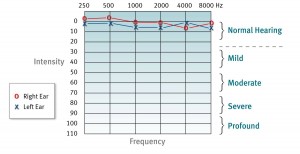
Hearing Assessments
A variety of tests will be carried out by your Audiologist in order to identify and diagnose the type and severity of your hearing loss. Once the various tests have been carried out, the Audiologist will have a good idea of how good or poor your hearing is and if there is any need for a referral to another specialist, i.e. GP or ENT. If there is a hearing loss present and no further management from a doctor is required, the option of hearing aids and/or assistive listening devices will be discussed.
blank
1. Full Diagnostic Assessment
OUTER EAR
- Otoscopy: This is an assessment of the outer ear ; where the Audiologist will shine a light into your ear canal in order to check for any foreign objects or obstructions which may prevent sound from entering the ear and passing through the auditory pathway. If there is an obstruction present, i.e. blockage of wax, a referral will be made to the appropriate specialist before further testing is done.
MIDDLE EAR
- Tympanometry: This is an assessment of the middle ear , which tests whether the functioning of the middle ear is normal. This test can detect the presence of fluid in the middle ear, blockage of wax, perforation on the ear drum and whether the ear drum is too stiff or flaccid for example. This is a very quick and painless test which only requires the patient to sit still and refrain from swallowing and talking.
- Acoustic Reflex Testing: A reflex is the result of contraction of muscles in the middle ear, in response to a loud sound/s. This is a protective mechanism in order to ensure that loud sounds do not damage the ear. This test identifies whether your reflexes are functioning as per normal.
INNER EAR
- Oto-Acoustic Emissions Testing (OAE’s): This test determines the outer hair cell functioning in the cochlea (organ of hearing) in the inner ear for newborns, children and difficult to test patients. The test is quick and painless but does require a relatively quiet room.
All of the above tests are non-invasive and do not require a subjective response from the patient. This therefore allows for accurate and objective test results. - Pure Tone Testing: Pure tone testing measures a person’s hearing sensitivity in each ear. Sounds are presented through earphones in a sound proof booth, at different frequencies of sound. The softest level at which the tone is heard is known as the hearing threshold. The patient is required to push a button or raise a hand when this tone is heard, which is then recorded on an audiogram. This plotted graph will show the type and degree of hearing loss and it is essential for the prescription of hearing aids. This test does require a subjective response from the patient, i.e. pushing a button.
- Speech Testing: The Audiologist will read out a list of words and the patient is required to repeat these words back. This then measures the lowest intensity at which one can recognize the words at a comfortable loudness level and be able to repeat them back. This test gives a good indication as to whether you would be a suitable candidate for hearing aids.


